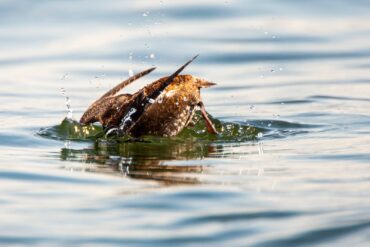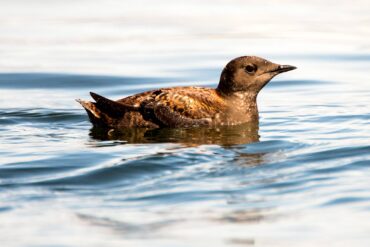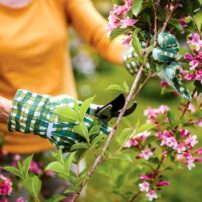
It’s a beautiful summer afternoon at Point No Point County Park in Hansville. Scores of people are relaxing on the beach. Suddenly, everyone springs up and runs to the water’s edge, excitedly pointing at something offshore. A trio of orcas are swimming by. Everyone is thrilled to see the stunning, endangered sea creatures.
But the people fail to notice another nearly endangered sea creature diving for fish, a mere stone’s throw from shore. As onlookers watch the iconic orcas swim by, an unassuming seabird, only slightly bigger than a robin, is foraging right in front of them. What the beachgoers don’t know is the double life of the marbled murrelet, another iconic, imperiled species of the Pacific Northwest that makes its living in both the forest and the sea.
The marbled murrelet is named for its marbled chest and belly in breeding season. The term “murrelet” acknowledges its diminutive size as compared to its cousin, the common murre. There are six species of murrelets, all of which live along the Pacific Coast and surrounding inland waters. Ancient murrelets visit the Salish Sea in winter.
The marbled murrelet is West Sound’s only year-round murrelet species. It’s most often seen from the north end of the Kitsap Peninsula and ferry crossings. Point No Point is the premier viewing spot, where they often feed close to shore in late spring and summer. The marbled murrelet’s range extends from southern Alaska to central California.

The marbled murrelet is a member of the alcid family, along with other Washington coastal species such as the common murre, rhinoceros auklet, pigeon guillemot and tufted puffin. But unlike these species, which nest in cliff burrows or in dense colonies on islands and sea stacks, the marbled murrelet had mysterious nesting habits — until recently.
For decades, the marbled murrelet baffled ornithologists with its unknown breeding location. When nesting season arrived, breeders disappeared. Finally, in 1974, the first nest in North America was discovered in a most unlikely place for a seabird. In California’s Redwoods State Park, a tree trimmer noticed a peculiar creature on a mossy branch 148 feet up a giant Douglas fir. He described the lone chick as a “porcupine with a beak” and was surprised to see that it had webbed feet. The tree was 6 miles away from the ocean.
Marbled murrelet pairs lay a single egg, about the size of a chicken egg, each year. No nest is made, just an indentation in soft moss on a high tree branch. In order for the moss to be thick enough and the branch to be wide enough to provide a safe nursery, the nest must be placed in old-growth rainforests near the coast.
Suitable nest sites are difficult to find. Pairs are known to fly 40 or more miles from the water to nest, if necessary. Commuting is done at night, above the treetops, to avoid aerial predators.
Parents rotate shifts every 24 hours. The egg is incubated for a month. The chick is ready to leave the nest after 27-40 days and stays with the parents into the fall.
In the nonbreeding season, the marbled murrelet switches from its marbled brown plumage to black-and- white tones. Pairs often stay together year-round and inhabit waters within 3 miles of shore. Foraging dives for small schooling fish can reach a depth of 200 feet.
As a result of its double life in marine waters and old-growth forests, the marbled murrelet faces incredible odds for survival. Individuals are capable of living up to 25 years, but many never reach old age. Threats to longevity include perils at sea, such as oil spills, other marine pollution and fishing nets, which can entangle diving birds, causing drowning.
Marbled murrelets are in steep decline. They’re listed as threatened under the federal Endangered Species Act. The population dropped by an astounding 44 percent between 2001 and 2016.
Nest success rates are extremely low due to destruction of old-growth forest, fragmentation of remaining habitat and nest predation. Some studies suggest that only 28 percent of nests are successful.
Because they nest exclusively in old-growth forests, marbled murrelets benefit from protection of habitat for the northern spotted owl, another iconic, threatened species of Washington that often inhabits the same forests used by breeding marbled murrelets.
In an uncertain world, birds offer an escape from troubled times. The marbled murrelet is an inspiration. Facing great odds, this bird only moves in one direction: forward.
Despite the many challenges it faces, the marbled murrelet keeps finding ways to survive. It may not stop beachgoers in their tracks, like a pod of orcas. But in its own way, it’s just as amazing. So head to Point No Point this summer and exclaim to the nearest visitor, “Look, there’s a marbled murrelet!”























Comments